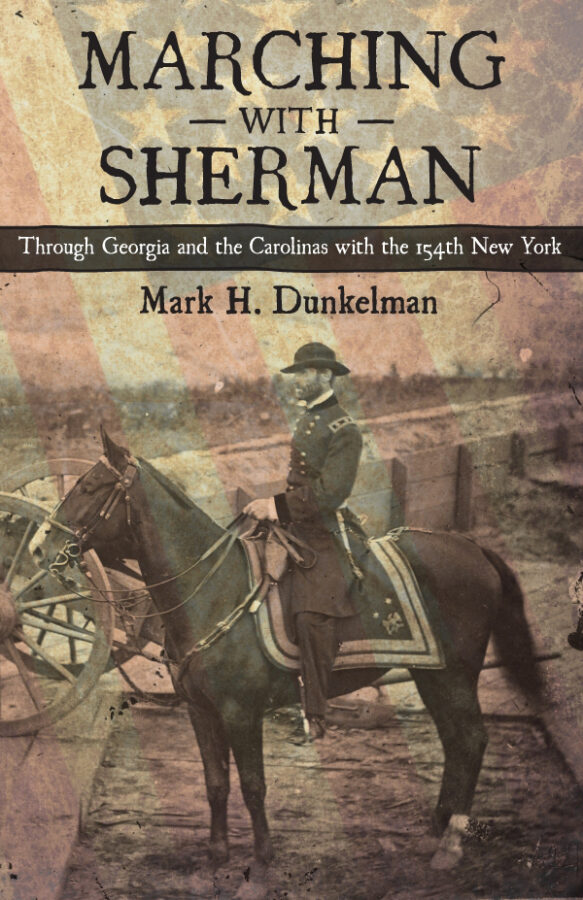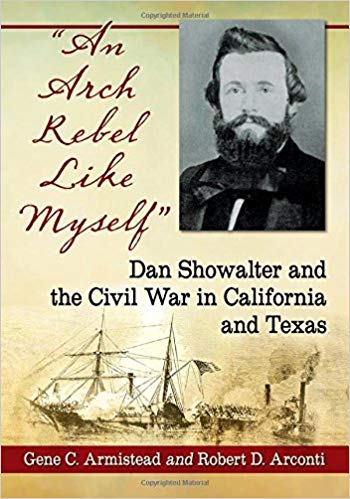Marching With Sherman: Through Georgia and the Carolinas With the 154th New York by Mark H. Dunkelman. Louisiana State University Press, 2012. Cloth, ISBN: 0807143782. $39.95.
 By now most accounts of Sherman’s war-altering campaigns across Georgia and then up through the Carolinas follow the same well-trod paths. Many books, like Noah Andre Trudeau’s Southern Storm, give compelling accounts of Union soldiers’ experiences as they made their way across the vulnerable underbelly of the Confederacy. Others, such as Edward Caudill and Paul Ashdown’s Sherman’s March in Myth and Memory, examine how Sherman and his men are remembered, and misremembered, in public memory. A very few, most important being Jacqueline Glass Campbell’s When Sherman Marched North from the Sea, consider in detail the experiences of white southerners as they encountered Sherman’s armies.
By now most accounts of Sherman’s war-altering campaigns across Georgia and then up through the Carolinas follow the same well-trod paths. Many books, like Noah Andre Trudeau’s Southern Storm, give compelling accounts of Union soldiers’ experiences as they made their way across the vulnerable underbelly of the Confederacy. Others, such as Edward Caudill and Paul Ashdown’s Sherman’s March in Myth and Memory, examine how Sherman and his men are remembered, and misremembered, in public memory. A very few, most important being Jacqueline Glass Campbell’s When Sherman Marched North from the Sea, consider in detail the experiences of white southerners as they encountered Sherman’s armies.
Whatever the many virtues these books have, in either intention or effect they all tend to separate what happened on the marches from how it was remembered by Yankees and Rebels, soldiers and civilians. Such a method is not necessarily problematic, but it fails to confer the advantages presented in Mark Dunkelman’s latest exploration of the actions and legacy of the New York 154th, his great-grandfather’s regiment, in Marching With Sherman.
As an independent historian Dunkelman has already written several well-received accounts of the 154th and related Civil War subjects. In this book he takes a fresh approach to examining the regiment’s history, one that, to my knowledge, also presents a new perspective on Sherman’s marches. The resulting narrative demonstrates, as Laurel Thatcher Ulrich puts it, that “history isn’t just what happens in the past. It is what later generations make of it” (9).
To do this, Dunkelman has brought together four types of literature on the marches usually treated separately. The first and most relied-on are Union sources—histories of the 154th, along with official reports, letters, diaries, and reminiscences. To these sources Dunkelman has added “accounts of southerners in Sherman’s path, studies of myths and legends of the march, and reports by postwar travelers” (7). (To be clear: In addition to including white southerners’ claims, Dunkelman makes impressive use of the relatively rare African-American witnesses, whose memories were preserved in the WPA slave narrative project.) Dunkelman lays these divergent and often flatly contradictory sources alongside one another for each stage of the 154th’s journey.
Of course, anyone even remotely familiar with the Civil War knows that Sherman’s marches are deeply controversial. Dunkleman’s achievement is to show in detail just how incommensurately northerners and southerners experienced, interpreted, and remembered the time Sherman came marching through, as well as how these differences in understanding and recollection have shifted by time and place.
At the same time, Dunkelman lays out his own interpretation of what happened, or most likely happened, on Sherman’s marches. His analysis is entirely sound, based on a thorough sifting of primary sources as well as over a century’s worth of secondary ones. While he’s troubled that Union soldiers, including his own great-grandfather, failed to record in their personal writings the true extent of destruction they inflicted (2-3, 189), most of his skepticism is reserved for southern accounts that demonize Sherman and turn his soldiers into rapacious barbarians.
This picture of the marches has long been rejected by informed and intellectually honest historians, but nonetheless Dunkelman makes a distinctive contribution to the case against Confederate defenders still gripped by ressentiment. Drawing from the work of academics such as Georgia folklorist Elissa Henken, Dunkelman shows that the vilifying accounts of Sherman are virtually archetypal, recurring even in locations far removed from where his soldiers marched.
For example, southerners repeated stories Dunkleman labels “dramatic piano interludes,” in which young women play music for the northern invaders. Some of these accounts “tell of reconciliation, others of confrontation, and still others of homes preserved as southern women serenaded Yankee soldiers over the keyboard” (118-19). One version told of a young South Carolina woman who reduced a Union officer to tears by a rendition of “Home, Sweet Home”; as a result, she was able to save her family’s manse from fiery destruction (135).
Other legends involve various means by which southerners outwitted or otherwise overcame their Yankee foes. There are innumerable accounts of homes or property being saved by the timely giving of a Masonic sign to a discerning Union officer (120, 127). Other “preservation tales” involve women hiding property in boxes or chests they then sat upon (120), or salvation brought by loyal and daring family slaves (148-49).
Even Confederate animals manage to defeat Sherman and his hellish minions. Story after story recounts a cow or pig “escaping from a butchering enemy and traveling great distances” back to its owners (134). Perhaps the most outlandish example involves the miraculous return of a cow to the people of Cheraw, South Carolina. After Sherman cruelly refused to leave a cow that could give milk to hungry infants, it fled the Yankees and swam home across the Pee Dee River, thus saving the babies from starvation.
Given the range of material Dunkelman so skillfully handles, it might seem caviling to question one feature of the book’s structure. To signal his reliance on the Union diaries that “shape the core of [his] book” (8), Dunkelman elected to follow a diary format, with each chapter broken by date into multiple sections. But this format doesn’t add anything essential, while stuttering the rhythm of his otherwise fine prose when several “entries” in a row are relatively short.
All in all, though, this is a path-breaking work in the study of Sherman’s campaigns. Dunkelman ends his book with the admission that he isn’t sure whether his great-grandfather would approve of his including southerners’ stories, but he decided to as “a simple matter of justice” (196). Nothwithstanding Dunkelman’s reservations about stories and memories deeply cherished by northerners and southerners, only the most unforgiving Yankee or the most unreconstructed rebel could fail to see that in Marching with Sherman he has afforded each side much more than merely that.
Thom Bassett teaches in the Department of English and Cultural Studies at Bryant University. He is writing a novel about William Tecumseh Sherman and the destruction of Columbia, South Carolina.
